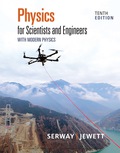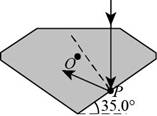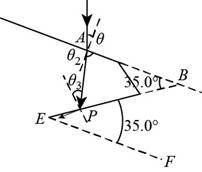
Concept explainers
(a)
The critical angle for total internal reflection for light in the diamond incident on the interface between the diamond and outside air.
(a)
Answer to Problem 28P
The critical angle of refraction at air-diamond interface is
Explanation of Solution
Given info: The condition for light ray travelling between air and a diamond is shown below.

Figure (I)
From Snell’s law of refraction to air-diamond interface to find the critical angle is,
Here,
The value of
Substitute 1 for
Thus, the critical angle of refraction at air-diamond interface is
Conclusion:
Therefore, the critical angle of refraction at air-diamond interface is
(b)
To show: The light travelling towards point
(b)
Answer to Problem 28P
The angle of incidence is more than the critical angle all light is reflected from point P.
Explanation of Solution
Given info: The condition for light ray travelling between air and a diamond is shown in figure (I).
The critical angle for total internal reflection for light in the diamond incident on the interface between the diamond and outside air is
Conclusion:
Therefore, the angle of incidence is more than the critical angle all light is reflected from point P.
(c)
The critical angle for total internal reflection for light in the diamond when the diamond is immersed in the water.
(c)
Answer to Problem 28P
The critical angle of incidence at water-diamond interface is
Explanation of Solution
Given info: The condition for light ray travelling between air and a diamond is shown in figure (I).
From Snell’s law of refraction to water-diamond interface to find the critical angle is,
Here,
The value of
Substitute 1 for
Thus, the critical angle of incidence at water-diamond interface is
Conclusion:
Therefore, the critical angle of incidence at water-diamond interface is
(d)
The ray incident at point
(d)
Answer to Problem 28P
Yes, the light ray undergoes total internal reflection at point
Explanation of Solution
Given info: The condition for light ray travelling between air and a diamond is shown in figure (I).
The critical angle for total internal reflection for light in the diamond incident on the interface between the diamond and water is
Thus, the light undergoes total internal reflection at
Conclusion:
Therefore, the light undergoes total internal reflection at
(e)
The direction in which the diamond is rotated such that the light at a point
(e)
Answer to Problem 28P
The diamond is rotated in clockwise direction on the axis perpendicular to the page through
Explanation of Solution
Given info: The condition for light ray travelling between air and a diamond is shown in figure (I).
The critical angle for total internal reflection for light in the diamond incident on the interface between the diamond and water is
The light will exit from the diamond only when the incident angle is less than the critical angle. So, to reduce the angle of incidence the diamond should be rotated in clockwise direction on the axis perpendicular to the plane of paper.
Thus, the light will exit at point
Conclusion:
Therefore, the light will exit at point
(f)
The angle of rotation at which the light first exit the diamond at point
(f)
Answer to Problem 28P
The diamond is rotated by
Explanation of Solution
Given info: The condition for light ray travelling between air and a diamond is shown in figure (I).
Let the angle is rotated clockwise by
Apply Snell’s law at the water-diamond interface.
The condition of the situation is shown below.

Figure (II)
The angle at the vertex
The requirement is that the angle of incidence
Apply Snell’s law and find angle
Substitute
Thus, the diamond is rotated by
Conclusion:
Therefore, the diamond is rotated by
Want to see more full solutions like this?
Chapter 34 Solutions
Physics for Scientists and Engineers with Modern Physics
- From your examination of the graph created using the data in Data Table 4 of Period, T vs √L . What would you determine is the relationship between the period of a pendulum and the length of a pendulum?arrow_forwardIn a certain bimetallic strip, the brass strip is 0.100% longer than the steel strip at a temperature of 283°C. At what temperature do the two strips have the same length? Coefficients of linear expansion for steel α = 12.0 × 10−6 K−1 and for brass α = 19.0 × 10−6 K−1 (see Table 13.2).arrow_forwardReview Conceptual Example 2 before attempting this problem. Two slits are 0.158 mm apart. A mixture of red light (wavelength = 693 nm) and yellow-green light (wavelength = 567 nm) falls on the slits. A flat observation screen is located 2.42 m away. What is the distance on the screen between the third-order red fringe and the third-order yellow-green fringe? m = 3 m = 3 m = 0 m = 3 m = 3 Fringes on observation screenarrow_forward
- A film of oil lies on wet pavement. The refractive index of the oil exceeds that of the water. The film has the minimum nonzero thickness such that it appears dark due to destructive interference when viewed in visible light with wavelength 643 nm in vacuum. Assuming that the visible spectrum extends from 380 to 750 nm, what is the longest visible wavelength (in vacuum) for which the film will appear bright due to constructive interference? Number Unitsarrow_forwardA piece of metal is placed on top of a 2.0 - kg wooden block (mass density = 562 kg/m³) piece. UseArchimedes' principle to calculate the mass (in kg) of copper if the top of the wood surface is exactly at thewater's surface?arrow_forwardA filmmaker wants to achieve an interesting visual effect by filming a scene through a converging lens with a focal length of 50.0 m. The lens is placed betwen the camera and a horse, which canters toward the camera at a constant speed of 7.9 m/s. The camera starts rolling when the horse is 36.0 m from the lens. Find the average speed of the image of the horse (a) during the first 2.0 s after the camera starts rolling and (b) during the following 2.0 s.arrow_forward
- What is the direction of the magnetic force on a NEGATIVE CHARGE that moves as shown in each of the six cases?arrow_forwardHi! I need help with these calculations for part i and part k for a physics Diffraction Lab. We used a slit width 0.4 mm to measure our pattern.arrow_forwardExamine the data and % error values in Data Table 3 where the angular displacement of the simple pendulum decreased but the mass of the pendulum bob and the length of the pendulum remained constant. Describe whether or not your data shows that the period of the pendulum depends on the angular displacement of the pendulum bob, to within a reasonable percent error.arrow_forward
 Physics for Scientists and Engineers: Foundations...PhysicsISBN:9781133939146Author:Katz, Debora M.Publisher:Cengage Learning
Physics for Scientists and Engineers: Foundations...PhysicsISBN:9781133939146Author:Katz, Debora M.Publisher:Cengage Learning Physics for Scientists and EngineersPhysicsISBN:9781337553278Author:Raymond A. Serway, John W. JewettPublisher:Cengage Learning
Physics for Scientists and EngineersPhysicsISBN:9781337553278Author:Raymond A. Serway, John W. JewettPublisher:Cengage Learning Physics for Scientists and Engineers with Modern ...PhysicsISBN:9781337553292Author:Raymond A. Serway, John W. JewettPublisher:Cengage Learning
Physics for Scientists and Engineers with Modern ...PhysicsISBN:9781337553292Author:Raymond A. Serway, John W. JewettPublisher:Cengage Learning Principles of Physics: A Calculus-Based TextPhysicsISBN:9781133104261Author:Raymond A. Serway, John W. JewettPublisher:Cengage Learning
Principles of Physics: A Calculus-Based TextPhysicsISBN:9781133104261Author:Raymond A. Serway, John W. JewettPublisher:Cengage Learning College PhysicsPhysicsISBN:9781305952300Author:Raymond A. Serway, Chris VuillePublisher:Cengage Learning
College PhysicsPhysicsISBN:9781305952300Author:Raymond A. Serway, Chris VuillePublisher:Cengage Learning College PhysicsPhysicsISBN:9781285737027Author:Raymond A. Serway, Chris VuillePublisher:Cengage Learning
College PhysicsPhysicsISBN:9781285737027Author:Raymond A. Serway, Chris VuillePublisher:Cengage Learning





